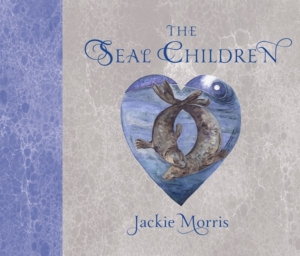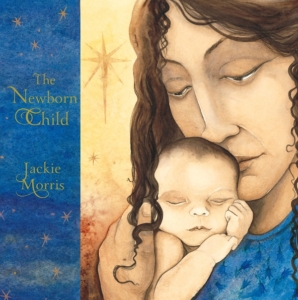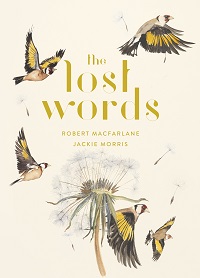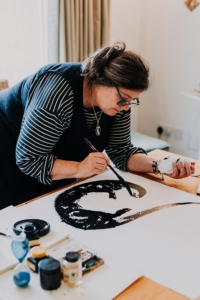Authorgraph No.260: Jackie Morris
Jackie Morris interviewed by Ferelith Hordon.
‘While words often need translation, and are often interpreted in many ways (reading between the lines), images need no translation; they speak across land borders and language borders, and across time…. Images cross borders in ways that words struggle to.’
Jackie Morris has a passionate belief in the power of the image – illustrations that accompany words, bringing them to life and extending understanding. One of our best-known book illustrators, she has an impressive catalogue of titles both illustrated and written by her, and those she has illustrated for other authors. She has won prizes – notably the Tir na n-Og and the CILIP Kate Greenaway Medal for The Lost Words in 2019. She has now been nominated for the Hans Christian Andersen Award for Illustration 2024 – the most prestigious international prize awarded to writers and illustrators.
Jackie Morris was born in Birmingham in 1961. Her father was a policeman and ‘my mum was a proper “mum”, she made pies and things’ she tells me. The family moved to Evesham in Worcestershire when she was four. Here she attended Prince Henry’s High School where she was frequently reprimanded for dreaming and drawing; she was told she could never be a painter – her ambition since childhood. She recalls at the age of six watching her father meticulously drawing the wing of a lapwing and ‘I decided to learn how to conjure birds from paper and colour.’ It is perhaps, this early inspiration that led to Jackie’s intense relationship with the natural world. Indeed she says she is much more comfortable depicting animals than people. This can be seen across the whole range of her work where we find wild life, birds, plants, and animals everywhere – many familiar to the British landscape and others more exotic – tigers, snow leopards, polar bears – and then the fabulous including her favourite, the dragon. However, the journey to the fluid, immersive spreads that capture this world was not immediate.
Starting at Hereford College for Art she moved to Exeter for her BA before finally obtaining a place at Bath Academy of Art, ‘a saving grace’. On leaving college, she found work creating postcards and calendars for organisations such as Greenpeace and Amnesty International as well as providing illustrations for a range of magazines – among them, New Statesman, Radio Times, New Society and Country Living. At this time she lived in London, taking her portfolio round the various publishing houses. It was while illustrating cards that her work caught the attention of the author Caroline Pitcher. The resulting collaboration led to Jackie’s first picture book, illustrating Caroline’s text for Jo’s Storm. The result brings together many of the elements that have become so significant in Jackie’s work – landscape and its importance, the respect for animals and how they are depicted, her use of watercolour, so fluid, combining energy with a sense of space. These can all be seen in her later works such as The Snow Leopard, where the relationship between the child and the wild animal and their snowy world are central to the narrative and the immersive illustrations capture the immensity of this mountain landscape, the vibrant palette of cold blues and whites, a contrast to the destructive drama created by the vivid reds and oranges of the invading warriors. In this book, Jackie is illustrating her own words; in The Lord of the Forest she is working with Caroline Pitcher again. Here we find the same intensity, same meticulous consideration and respect for the world of the tiger. As she herself comments, when creating images for the text of someone other than herself she tries to get the soul of the writing. Indeed, there is strong spiritual element in Jackie’s work.
 Just as the natural world inspires awe so do the stories emerging from the world’s religions. Jackie
Just as the natural world inspires awe so do the stories emerging from the world’s religions. Jackie has illustrated a number of books where this can be seen. In particular her series with Mary Hoffman – Parables: Stories Jesus Told, Miracles Jesus worked and Animals of the Bible. These are notable not just for the palette, which draws the young reader into the landscape of the Middle East, but also in her depiction of the people of that part of the world. Though she does not use models, when illustrating the Nativity story, Little One, We Knew You’d Come by Sally Lloyd-Jones she took care to have a real baby at its heart. Her integrity shines through. What also shines through is her love of story. This is love that goes back to her childhood, very much inspired by her father, though reading did not come easily to her. Indeed, as she says even today ‘I read word by word, it takes ages and that’s how I write’. From the beginning she has been drawn into the wonder of folklore and fairy tale. Here she can evoke the sense of another world – that feeling expressed by the words ‘once upon a time’. In both Cities in the Sea by Sian Lewis and in The Seal Children for which she wrote the text, she captures the haunting atmosphere of Celtic myth to great effect. Her palette of soft sepia browns and the blue of the sea colours echoed in the costumes of the fisher folk bring reality and humanity to the tales. Both of these picture books which come from the beginning of her career were awarded the Tir na n-Og Prize. In her own retellings, East of the Sun, West of the Moon and The Wild Swans, she takes the time to expand the tales, keeping the traditional element at their heart but adding and shaping them to meet a contemporary audience while her jewel-like illustrations add that moment of visual excitement to draw the reader in. This ability to bring fantasy alive is apparent in Quiet Music of Gently Falling Snow which brings her work to an adult audience as her imaginative picture book Tell me a Dragon does for a very much younger audience, while the illustrations for her collection of Nursery Rhymes draws both young and old together to play with the wonder of the familiar words,
has illustrated a number of books where this can be seen. In particular her series with Mary Hoffman – Parables: Stories Jesus Told, Miracles Jesus worked and Animals of the Bible. These are notable not just for the palette, which draws the young reader into the landscape of the Middle East, but also in her depiction of the people of that part of the world. Though she does not use models, when illustrating the Nativity story, Little One, We Knew You’d Come by Sally Lloyd-Jones she took care to have a real baby at its heart. Her integrity shines through. What also shines through is her love of story. This is love that goes back to her childhood, very much inspired by her father, though reading did not come easily to her. Indeed, as she says even today ‘I read word by word, it takes ages and that’s how I write’. From the beginning she has been drawn into the wonder of folklore and fairy tale. Here she can evoke the sense of another world – that feeling expressed by the words ‘once upon a time’. In both Cities in the Sea by Sian Lewis and in The Seal Children for which she wrote the text, she captures the haunting atmosphere of Celtic myth to great effect. Her palette of soft sepia browns and the blue of the sea colours echoed in the costumes of the fisher folk bring reality and humanity to the tales. Both of these picture books which come from the beginning of her career were awarded the Tir na n-Og Prize. In her own retellings, East of the Sun, West of the Moon and The Wild Swans, she takes the time to expand the tales, keeping the traditional element at their heart but adding and shaping them to meet a contemporary audience while her jewel-like illustrations add that moment of visual excitement to draw the reader in. This ability to bring fantasy alive is apparent in Quiet Music of Gently Falling Snow which brings her work to an adult audience as her imaginative picture book Tell me a Dragon does for a very much younger audience, while the illustrations for her collection of Nursery Rhymes draws both young and old together to play with the wonder of the familiar words,
Her paintings may appear reassuringly classical in their composition and technique; they satisfy the eye through the imagery and colour, her  bold use of space. Though she used gouache for the images in Song of the Golden Hare she now works almost exclusively in watercolour. However, even here she is breaking rules. ‘I have never used watercolour in the way you are supposed to’ she tells me. ‘I do use washes but I work by building up layer on layer’ – the result is that they shine with depth and texture. Jackie is constantly exploring new and innovative ideas. This interest in experimenting is very apparent in Feather, Leaf, Bark and Stone where she takes these unconventional materials to explore texture and impressions. She is currently painting in watercolour on clay board – a very untraditional practice but one which will bring life to the book she and Robert Macfarlane are working on about birds. Indeed, innovation is at the heart of her earlier collaboration with Macfarlane, The Lost Words. She is very definite that this extraordinary book that has had such an impact across the book world and inspired both adult and children, is indeed a very real collaboration. In her words ‘It is a book that has taken them to so many places.’ She certainly suggested it – she asked Robert for an introduction to a book she planned using the lost words. She created the design in which the images move across three spreads allowing one to be a ghost image and a design that challenged the traditional expectations of a picture book. The result though is a true partnership where Robert’s spells, which use ‘words you can taste’, work seamlessly with her paintings. But Jackie is also quick to recognise the contribution made by her editor, the publisher, the designer, all those who have contributed to the making of the book– and the public who have taken it to their heart
bold use of space. Though she used gouache for the images in Song of the Golden Hare she now works almost exclusively in watercolour. However, even here she is breaking rules. ‘I have never used watercolour in the way you are supposed to’ she tells me. ‘I do use washes but I work by building up layer on layer’ – the result is that they shine with depth and texture. Jackie is constantly exploring new and innovative ideas. This interest in experimenting is very apparent in Feather, Leaf, Bark and Stone where she takes these unconventional materials to explore texture and impressions. She is currently painting in watercolour on clay board – a very untraditional practice but one which will bring life to the book she and Robert Macfarlane are working on about birds. Indeed, innovation is at the heart of her earlier collaboration with Macfarlane, The Lost Words. She is very definite that this extraordinary book that has had such an impact across the book world and inspired both adult and children, is indeed a very real collaboration. In her words ‘It is a book that has taken them to so many places.’ She certainly suggested it – she asked Robert for an introduction to a book she planned using the lost words. She created the design in which the images move across three spreads allowing one to be a ghost image and a design that challenged the traditional expectations of a picture book. The result though is a true partnership where Robert’s spells, which use ‘words you can taste’, work seamlessly with her paintings. But Jackie is also quick to recognise the contribution made by her editor, the publisher, the designer, all those who have contributed to the making of the book– and the public who have taken it to their heart
‘It is very difficult to be taken seriously as a writer if you are seen as an illustrator’ – and Jackie to most people will be seen as a consummate artist and illustrator. For Jackie the words are as important as the image – ‘writing is a real passion for me’ she says, but she never thought that she could be an author. Now she is turning more to be the creator of the text, teaming up with other illustrators. She talks with pride about her work with James Mayhew and the three books she has written about Mrs Noah – a character she would like to develop further. She is the author of the forthcoming The Panda’s Child for which Cathy Fisher has created the images. ‘Watching Cathy paint the images for The Panda’s Child was just wonderful. Each one has heart and soul poured into it. Together, I hope, we have made something beautiful.’ It will also challenge since it will be a picture book in three chapters that she hopes will open the door to conversation and thought, especially about the trade in wild animals. It breaks the rules, she tells me. She and Cathy are now working on The Summer Pup, a story about one of Jackie’s dogs, Rosie, that has been in her mind for a long time. Another book in the making is one for adults working with the glass artist, Tamsin Abbott, using folk and selkie tales – another innovation. It is this generosity – her willingness to collaborate – her connection with the natural world around her, her belief that all art is curiosity, that makes Jackie such a special author and artist. She still lives in the little house she bought on her first visit to Pembrokeshire. ‘I came for a weekend. I arrived after dark and woke to a sky so blue and clear. There was the cathedral in the dip then fields and the sea and tiny islands and there and then I fell in love… I went shopping and bought a house.’ It was an adventure, and it is this sense of adventure that still informs her art as she works to give expression to her dreams– ‘I love the place that writing takes me to inside my head’ she says, while her images take her audience to that special place. They tell her ‘they had to buy a picture because it was in their dreams…That really is a privilege, to be able to get into people’s dreams.’
Ferelith Hordon is editorial advisor to Books for Keeps.





